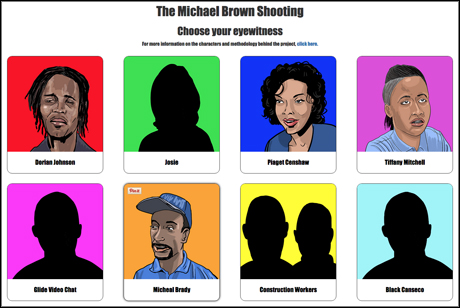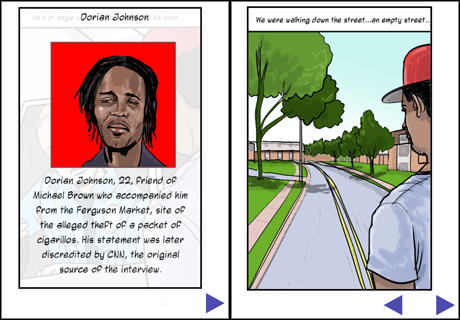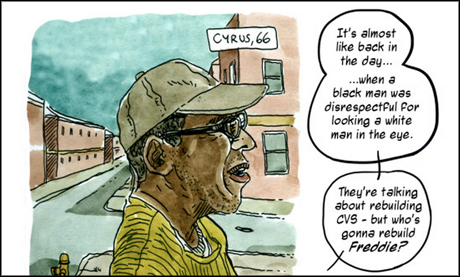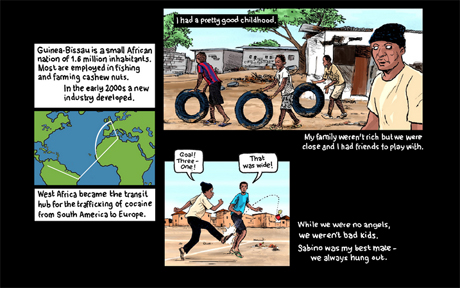
Art is an ancient medium for storytelling, certainly older than the written word and maybe older than language itself. But in journalism, art is often limited to single frame cartoons or consigned to the 'funny pages' instead of being seen as serious reporting.
The Illustrated London News bucked the trend for 160 years, closing in 2003, and now, with the broadening capabilities of digital journalism, the industry is seeing a revival in innovative journalistic storytelling through art.
Proponents of this new wave in graphic or comics journalism are integrating mobile devices, interactive elements, film and animation, and believe the medium can serve some purposes that other formats may not.
Making journalism more accessible
"Comics are immediately accessible and relatable to a lot of people in a way that, curiously, film or written journalism might not be," said illustrator Lindsay Pollock, who has worked on a number of graphic journalism projects, in a recent Journalism.co.uk podcast.
"And people really relate to cartoon characters, from childhood basically. Obviously there's a reason why comics and cartoons are so popular and it is precisely because they touch something in people."
Such is true for a recent story produced by Ben Dix, founder of graphic journalism organisation PositiveNegatives, featured in the Guardian recently. It tells the tale of Abike, a woman tricked into leaving Nigeria for work then forced into sexual slavery before being imprisoned by UK authorities.
Warning: the following video has some distressing scenes
Abike's Story, from the Guardian. The printed comic is also available on the Guardian's website
"At the end of that comic, reading about one girl who was trafficked to London from Nigeria, you can then go into all the other articles on the Guardian about modern day slavery and sex trafficking," said Dix, "and suddenly Abike's story is contextualised among those statistics.
"But you're reading a very, very graphic account of one girl's experience. When we put that out I was amazed... so many people didn't know the ins and outs of what it is to be sex trafficked to the UK and then you're seeing this in the comic. So would they have read that article if it was just another article in the newspaper? The comic jumps out of the newspaper and people are attracted to reading it."
It can also help relay information to people or communities where literacy rates or language barriers may be otherwise problematic. Hasit Shah, a former BBC journalist, received funding from the Knight Foundation in February for Ketla, a mobile app delivering graphic journalism stories to Indian communities.
"In India there's a huge tradition, a long tradition of comic books for storytelling," he said. And when there are hundreds of languages in India and very low connection rates in some areas, he hopes a more visual storytelling style will reach a larger audience.
"Given that literacy rates, especially in rural India, are so shockingly bad still... we wanted it to be very light on text, so it had to be visual. The visual element is not necessarily just a technical one, but it's a practical thing for people who don't read or write very well. And there are loads of them."
Let sources tell their own story
Photojournalist Marc Ellison takes what he calls an 'anthropographic' approach to some of his work, and believes graphic journalism can give people the chance to tell their own stories rather than through a reporter.
His current project, funded by the European Journalism Centre, details the lives of four women in Uganda, as they rejoin society after spending years at the mercy of militant group the Lord's Resistance Army.
When finished, the work will combine artistic interpretations with photographs and audio of the women's testimony in a multimedia graphic novel.
"I'm always fully aware of not telling these women's stories through – not only a westerner's lens – but a white, western male's lens," he said. "So I do my best to not obscure the narrative and to give them the opportunity to tell their own stories."
Warning: The following video begins with a disturbing story
An introduction to Marc Ellison's graphic journalism project, on the reintegration of female child soldiers into society in Uganda
Protecting sources
The women in Ellison's work have survived more than anyone should have to, and the telling of their stories is intended as a form of catharsis in dealing with their experience.
Ben Dix founded his organisation PositiveNegatives for a similar reason after being evacuated from Sri Lanka during the civil war.
He had been working for the UN and left many friends and colleagues behind but has found telling the stories has helped him come to terms with what happened.
"One of the initial issues that we had when we were doing the Sri Lanka piece was that a lot of the contributors were vulnerable individuals in vulnerable situations," said Lindsay Pollock, who does much of the art that accompanies Dix's work.People who might not have been comfortable giving their testimony explicitly as themselves were able to be very explicit with usLindsay Pollock, illustrator
"Perhaps they were asylum seeking in the UK or had family members and loved ones back in Sri Lanka who could potentially suffer reprisals if they spoke out explicitly about their experiences. So one thing about producing their stories as comics is that it allows them to anonymise those characters."
The same applies to other projects Dix has produced at PositiveNegatives, including the story of Abike.
She has now built a life for herself in London and her children have joined her, but her real identity is protected without limiting the impact of her story.
"People who might not have been comfortable giving their testimony explicitly as themselves were able to be very explicit with us," continued Pollock, "and unburden themselves from these stories, safe in the knowledge that names would be changed.
"You can't be identified when you've been turned into a cartoon character. That was an initial impulse and it allowed us to get to the heart of these stories."
Multiple perspectives
Graphic journalist Dan Archer used his artistic skills for the testimonies of eyewitnesses to shooting of unarmed black teenager Michael Brown, in Ferguson, Missouri last summer.
Users can select the eyewitness they want to hear from and flick through the frames of their testimony, illustrated by Archer and accompanied by text of their version of events.

"It's what a lot of people have been calling an inherently Rashomon-esque style," he said, referencing the classic Japanese film famous for presenting different viewpoints, "where you can, I think, visually represent a lot of juxtaposed testimonies side by side without it being too cognitively dissonant for the user.
"People often want one single cohesive thread to climb through a story with and I think comics allow you to play with that, especially interactive comics.
"They allow you to say 'well, here's one way through it and here's another and here's a third way. And now you have to choose which do you think is the most credible'," said Archer.

Reporting tips
Both Archer and Dix have found the medium helps them get better access and interviews than if they were to arrive at the scene with a camera, but still gives the immediacy and immersion in storytelling because of its visual nature.
When Baltimore resident Freddie Gray died in policy custody earlier this year, Archer took to the streets with just a pen and a sketchbook.
"It was especially powerful because I really wouldn't have been able to go into that scene and talk to those people as a journalist in that capacity without offering something a bit different," he said.
"I felt like a lot of people were turning up and doing the 'give me your soundbites' thing. But by having these conversations and then being able to show them [the sketches] afterwards it's almost like slow journalism, it encourages you to listen more."

Dix spent three weeks with crack addicts in Guinea-Bissau earlier this year for 'Hooked', a BBC World Africa in Focus story about addiction in the country.
"We shared our life stories and I told them as much about my family and my life growing up as they did about theirs and at the end of it we were friends," he said.
"It didn't feel like we were interviewing them, it felt like we were hanging out and getting to know each other and from that I wrote the script, they reviewed the script, they edited the script and we came back and illustrated it."
Taking a lot of photographs on location has always been very important to accurately portray the story later, but most of the process comes through detailed and extensive reporting, as with all fields of journalism.

"What I really like about comics is their non-intrusive interviewing techniques," Dix continued. "We can sit back with a cup of tea and just chat.
"I record the audio so I've got it all there to fact check later on, but I don't need to put cameras in people's faces or set up the lighting or anything like that. We can just sit under a tree and talk the afternoon away."
Challenges
Graphic or comics journalism is often criticised for not being as objective as other media, and this is still one of the main challenges the field faces.
Dix and Pollock admit that sometimes the best way to tell a story is to take some artistic license in its telling, but the stories themselves are always grounded in truth.
"We're still very conscious that we are a mediating presence between the contributors and the reader," Pollock said.You've got the total freedom of the page or screen or mobile device to play withDan Archer, graphic journalist
"And we do our best to be as true as possible to the stories as they are told to us. But there is a degree to which you have to shape these things and a comic is not real life. We're quite careful about not actually describing what we do as journalism."
Ellison and Archer take a different approach, however, preferring to stay as true to the story in their telling of events as possible.
This can often mean adding sources and attributions in pop up boxes or other interactive elements that don't get in the way of the story but still offer context.
"The one thing that I've always done throughout my work is use very simple interactivity to address some of the concerns that some people bring to comics," he said.
"And I would hyperlink back to my sources, I would put original material like thumbnail pages or my notes embedded in some of the images, I would incorporate different forms of multimedia so you could have video rollovers or hyperlink rollovers, bits and bobs to make it more than just a slideshow."
He is hopeful that the field will gain more mainstream recognition though, and intends to keep exploring virtual reality and other media.
"The beauty of comics is there is no fixed, prescribed way [to tell a story] because really you've got the total freedom of the page or screen or mobile device to play with.
"So it's only really bounded by the evidence that you have, the material you have to work with and your imagination."
Listen to the full podcast with Pollock, Dix, Shah, Archer and Ellison below:
Free daily newsletter
If you like our news and feature articles, you can sign up to receive our free daily (Mon-Fri) email newsletter (mobile friendly).
Related articles
- Four tools for journalists to try this summer
- Tip: Seven mobile apps for graphic design
- The Economist is using interactive data-driven Stories to widen its Instagram community
- Aesthetic journalism: Overcoming censorship and documenting Syrian conflict with a sketchbook
- BBC experiments with new virtual studio to better explain the news to young people across Africa









